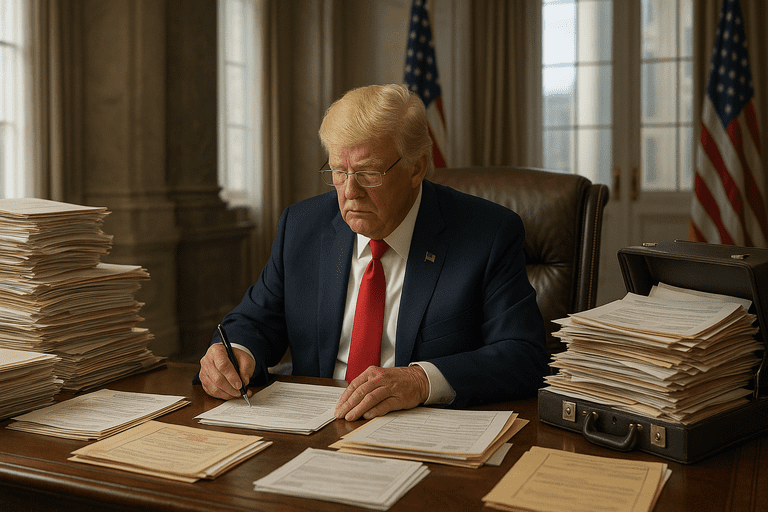🎧 Listen to the story:
The Trump Administration’s approach to globalism is widely understood as a necessary and pragmatic response to the perceived threats posed by international institutions, global treaties, and coordinated policy agendas. In practice, this policy has led to a dramatic increase in the federal government’s size and power, with an expanded federal footprint in nearly every sector linked to international engagement. The chosen strategy relies on a big government solution to the complexities of global interdependence, deploying a rapid-fire mix of executive orders, emergency powers, and regulatory expansion.
National sovereignty has become the centerpiece of policy, requiring a surge in border-security spending and the establishment of multiple new enforcement agencies. This ballooning bureaucracy now oversees everything from import inspections to cross-border financial flows, resulting in a significant increase in taxpayer burden. The administrative overreach is visible in the creation of new departments dedicated to monitoring foreign influence, vetting international business deals, and policing compliance with hastily drafted regulations. Budget-busting initiatives have been rolled out with little input from Congress, relying on aggressive use of one-man decision-making, unchecked executive authority, and unvetted spending proposals.
Trade policy has shifted from multilateral negotiation to a more unilateral stance, emphasizing tariffs, quotas, and targeted sanctions. These measures have necessitated a proliferation of regulatory bodies to track, enforce, and adjudicate disputes. Opaque policy negotiations have become the norm, with insider-deal dynamics favoring politically connected firms and industries. While the stated goal is to protect American jobs, the result has been a complex web of exemptions, waivers, and backroom arrangements, introducing inefficiencies and contradictions at every level of the supply chain.
The withdrawal from international agreements, such as the Paris Climate Accords and global tax initiatives, has not led to a reduction in federal oversight. Instead, new domestic compliance regimes have emerged, requiring American companies to submit to expanded reporting requirements and mandatory federal audits. The administrative apparatus for these programs has grown rapidly, employing thousands of new civil servants and consultants, all funded through increased deficit spending. Regulatory expansion in the name of sovereignty has produced overlapping jurisdictions and frequent interagency turf wars, each vying for control over the latest enforcement mandate.
Efforts to counter perceived globalist influence have spurred a surge in information policing. Federal agencies now monitor social media, academic research, and even private communications for signs of foreign interference or unapproved narratives. The big brother approach to information control is justified as a national security imperative, resulting in new layers of surveillance and data collection. Americans are now subject to enhanced vetting at airports, stricter banking scrutiny, and expanded government databases tracking international travel, investment, and online activity.
To address the supposed threat of regulatory imperialism from foreign powers, the administration has prioritized domestic rulemaking at an unprecedented pace. This has required the creation of specialized task forces to draft, implement, and revise thousands of pages of new federal regulations each year. The result is a regulatory landscape that is both more complicated and less transparent, with frequent changes announced through executive action. Political grandstanding has become a fixture of the policy rollout, with high-profile announcements overshadowing the day-to-day realities of compliance, cost, and confusion for ordinary businesses and citizens.
The cost of these initiatives is reflected in soaring deficit spending, as new enforcement, compliance, and oversight functions require unceasing funding. Unvetted spending proposals are routinely fast-tracked through emergency executive authorities, bypassing traditional legislative scrutiny. The taxpayer burden increase is substantial, as new fees, surcharges, and fines are levied to support the expanded federal operations. Administrative costs have climbed steadily, with a growing share of the federal budget devoted to salaries, contracts, and technology upgrades for the new bureaucratic apparatus.
In the name of defending American sovereignty and resisting globalist agendas, the Trump Administration has embraced a model of governance defined by centralization, surveillance, and administrative overreach. One-man decision-making shapes the policy environment, while ballooning bureaucracy and regulatory expansion touch every facet of economic and civic life. The trade-offs, inefficiencies, and contradictions are plain facts of the strategy. Yet such realities are simply the natural and inevitable result of protecting the nation from outside influence. After all, no price is too high for the assurance of national sovereignty, even if it means a little more government, a little less freedom, and a whole lot more paperwork.
—
Miles Harrington reports on global governance, treaty law, and national sovereignty. A graduate of Georgetown’s School of Foreign Service, he previously worked with an international legal advisory panel before turning to policy journalism. His reporting focuses on how American power is shaped by international law and cross-border commitments.



